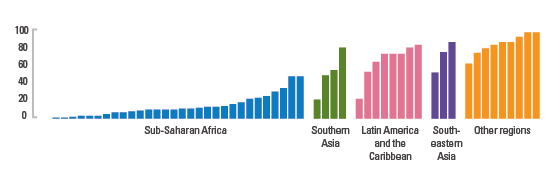The benefits associated with improved hygiene are well established but it was not included in the Millennium Development Goal (MDG) targets.
International consultations on priorities for global monitoring post-2015 recommend an integrated approach to drinking water, sanitation and hygiene (WASH) in order to maximise positive impacts on the health, welfare and productivity of populations. Of the range of hygiene behaviours considered important for health, hand washing with soap is a top priority in all settings. Access to basic facilities for menstrual hygiene management is critically important for women’s health, safety and dignity and can be monitored in institutional settings including schools and health facilities.
Monitoring handwashing behaviour is difficult but the presence of soap and water at a designated place has been shown to be a robust proxy indicator. In collaboration with the Multiple Indicator Cluster Survey (MICS) team, a handwashing module was developed and has been included in major household surveys since 2009. Data from over 50 countries reveal that current levels of hand washing with soap are generally low. Disparities in access are found between different groups and by setting, including between urban and rural areas. As the number of countries with more than one survey increases, it will become possible to assess and compare trends over time.
Progress on Sanitation and Drinking Water 2015 Assessement and MDG update
Looking back on 25 years of water, sanitation and hygiene monitoring, the report provides a comprehensive assessment of progress since 1990. The MDG target for drinking water was achieved in 2010 but the world has missed the sanitation target by almost 700 million people. In 2015, 663 million people still lack improved drinking water sources, 2.4 billion lack improved sanitation facilities and 946 million still practice open defecation.
WHO/UNICEF JOINT MONITORING PROGRAMME FOR WATER SUPPLY AND SANITATION
Since 1990, WHO and UNICEF have tracked progress on global water and sanitation goals through the Joint Monitoring Programme for Water Supply and Sanitation (JMP). The JMP monitors trends in coverage; helps build national monitoring capacity in developing countries; develops and harmonises questionnaires, indicators and definitions to ensure comparability of data over time and among countries; and informs policymakers of the status of the water supply and sanitation sector through annual publications. The JMP draws guidance from a technical advisory group of leading experts in water supply, sanitation and hygiene, and from institutions involved in data collection and sector monitoring. Further information about the JMP and its methodology can be found at the JMP website.
DATA SOURCES
The JMP estimates for handwashing are based on information collected in household surveys such as Multiple Indicator Cluster Surveys (MICS) and Demographic and Health Surveys (DHS). Household surveys are usually conducted by national institutes of statistics, carried out by trained national staff who collect information on a wide range of health and living conditions through face-to-face interviews. Nationally owned and independently verifiable, these data sources provide national governments with a periodic update of the status and progress with respect to handwashing. Increasingly household survey data allow for assessing disparities in access by marginalized populations and geographic areas.
DEFINITION OF HANDWASHING FACILITIES WITH SOAP AND WATER
The presence of soap and water at a designated place is used a proxy for handwashing behaviours. Households are considered to have access if enumerators observe a place for handwashing and both water and soap are available.



